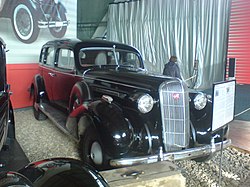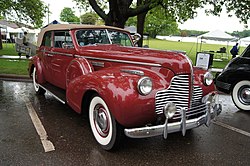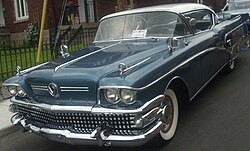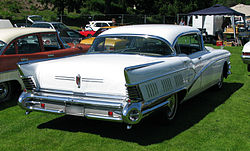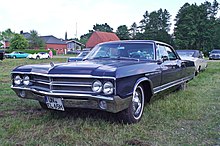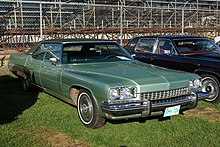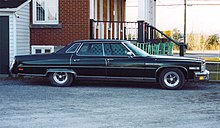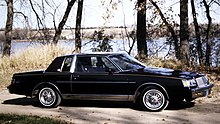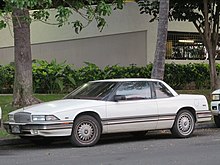Buick is a division of the American automobile manufacturer General Motors (GM). Started by automotive pioneer David Dunbar Buick in 1899, it was among the first American automobile brands and was the company that established General Motors in 1908. Before the establishment of General Motors, GM founder William C. Durant had served as Buick's general manager and major investor. With the demise of Oldsmobile in 2004, Buick became the oldest surviving American carmaker.

The Buick Skylark is a passenger car formerly produced by Buick. The model was made in six production runs, during 46 years, over which the car's design varied dramatically due to changing technology, tastes, and new standards implemented over the years. It was named for the species of bird called skylark.

The Buick Riviera is a personal luxury car that was marketed by Buick from 1963 to 1999, with the exception of the 1994 model year.

The Buick Electra is a full-size luxury car manufactured and marketed by Buick from 1959 to 1990, over six generations. Introduced as the replacement for the Roadmaster lines, the Electra served as the flagship Buick sedan line through its entire production and was offered as a six-passenger four-door sedan with two-door sedan, two-door convertible, and five-door station wagon variants.

The Oldsmobile 98 is the full-size flagship model of Oldsmobile that was produced from 1940 until 1942, and then from 1946 to 1996. The name – reflecting a "Series 90" fitted with an 8-cylinder engine – first appeared in 1941 and was used again after American consumer automobile production resumed post-World War II. It was, as it would remain, the division's top-of-the-line model, with lesser Oldsmobiles having lower numbers such as the A-body 66 and 68, and the B-body 76 and 78. The Series 60 was retired in 1949, the same year the Oldsmobile 78 was replaced by the 88. The Oldsmobile 76 was retired after 1950. This left the two remaining number-names to carry on into the 1990s as the bread and butter of the full-size Oldsmobile lineup until the Eighty Eight-based Regency replaced the 98 in 1997.

The Pontiac Catalina is a full-size, junior series automobile produced by Pontiac from 1950 to 1981. Initially, the name was a trim line on hardtop body styles, first appearing in the 1950 Chieftain Eight and DeLuxe Eight lines. In 1959, it became a separate model as the "entry-level" full-size Pontiac.

The Pontiac Bonneville is an automobile built by Pontiac from 1957 until 2005. Bonnevilles were full-sized, with the exception of a brief period of mid-size between 1982 and 1986. The brand was introduced as a limited production performance convertible during the 1957 model year. The Bonneville, and its platform partner, the Grand Ville, are some of the largest Pontiacs ever built; in station wagon body styles they reached just over 230 inches (5.8 m) long, and at 5,000 pounds (2,300 kg) and more were also some of the heaviest cars produced at the time.

The Buick Special was an automobile produced by Buick. It was usually Buick's lowest-priced model, starting out as a full-size car in 1936 and returning in 1961 as a mid-size. The Special was built for several decades and was offered as a coupe, sedan and later as a station wagon. When GM modernized their entry level products in the 1960s, the Special introduced the modern Buick V6 that became a core engine for GM for several decades and lived on in upgraded form until 2006.

Buick Century is the model name that was used by Buick for a line of upscale full-size cars from 1936 to 1942 and 1954 to 1958, as well as from 1973 to 2005 for mid-size cars.

The Oldsmobile Starfire is an automobile nameplate used by Oldsmobile, produced in three non-contiguous generations beginning in 1954. The Starfire nameplate made its debut as a convertible concept car in 1953 followed with the 1954–1956 Ninety-Eight series convertibles that shared a "halo status" with the Buick Skylark and Cadillac Eldorado. For 1957 only, all Ninety-Eight series models were named "98 Starfire ".

The Chrysler Imperial, introduced in 1926, was Chrysler's top-of-the-line vehicle for much of its history. Models were produced with the Chrysler name until 1954, after which it became a standalone brand; and again from 1990 to 1993. The company positioned the cars as a prestige marque to rival Cadillac, Continental, Lincoln, Duesenberg, Pierce Arrow, Cord, and Packard. According to Antique Automobile, "The adjective ‘imperial’ according to Webster's Dictionary means sovereign, supreme, superior or of unusual size or excellence. The word imperial thus justly befits Chrysler's highest priced model."

Buick Estate is a nameplate that was used by the Buick division of General Motors, denoting its luxury full-size station wagon from 1940 to 1964 and from 1970 to 1996. The Estate nameplate was derived from the term country estate in wealthy suburban areas and estate car, the British term for a station wagon.

The Buick Roadmaster is an automobile that was built by Buick from 1936 until 1942, from 1946 until 1958, and then again from 1991 until 1996. Roadmasters produced between 1936 and 1958 were built on Buick's longest non-limousine wheelbase and shared their basic structure with the entry-level Cadillac Series 65, the Buick Limited, and after 1940, the Oldsmobile 98. Between 1946 and 1957 the Roadmaster served as Buick's flagship.

The Buick LeSabre is a full-size car made by the division Buick of General Motors from 1959 until 2005. Prior to 1959, this position had been retained by the full-size Buick Special model (1936–58). The "LeSabre", which is French for "the sabre", was Buick's mid-level full-size sedan above the Special but below the Electra during the 1960s then remained in its market position when the Electra was replaced with the Park Avenue. The LeSabre was available as a 2-door convertible, sedan or hardtop, a 4-door sedan or hardtop and station wagon throughout its production.
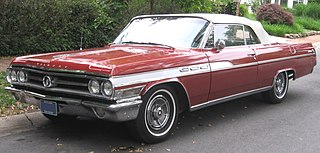
The Buick Wildcat is a full-size car that was produced by Buick from the 1963 to 1970 model years. Taking its name from a series of 1950s Buick concept cars, the Wildcat replaced the Invicta within the "junior" B-body Buick sedan range. Serving as the higher-performance full-size Buick, the Wildcat was slotted between the LeSabre and the larger C-body Electra.

The Cadillac Sixty Special is a name used by Cadillac to denote a special model since the 1938 Harley Earl–Bill Mitchell–designed extended wheelbase derivative of the Series 60, often referred to as the Fleetwood Sixty Special. The Sixty Special designation was reserved for some of Cadillac's most luxurious vehicles. It was offered as a four-door sedan and briefly as a four-door hardtop. This exclusivity was reflected in the introduction of the exclusive Fleetwood Sixty Special Brougham d'Elegance in 1973 and the Fleetwood Sixty Special Brougham Talisman in 1974, and it was offered as one trim package below the Series 70 limousine. The Sixty Special name was temporarily retired in 1976 but returned again in 1987 and continued through 1993.

The Cadillac Series 40-62 is a series of cars which was produced by Cadillac from 1940 through 1964. Originally designed to complement the entry level Series 61, it became the Cadillac Series 6200 in 1959, and remained that until it was renamed to Cadillac Calais for the 1965 model year. The Series 62 was also marketed as the Sixty-Two and the Series Sixty-Two. The Series 62 was used to introduce the Cadillac Coupe de Ville and the Cadillac Eldorado which started out as special appearance packages that were later placed into production.

The Cadillac Series 61 was Cadillac's mainstream product model range. It was priced and equipped more modestly below the limousine, GM D platform Cadillac Series 85, Cadillac Series 90, Cadillac Series 72, Cadillac Series 67, and Cadillac Fleetwood Series 75. It was upgraded to the Series 62 in 1940 only to return to production in model year 1941, replacing the cancelled LaSalle Series 50. While production was suspended from model years 1943–1945 due to World War II, it remained as the junior level product line until 1951. The size, equipment list and quality level were the most popular with buyers who wanted a prestigious luxury car that was usually driven by the owner, while the longer cars were chauffeur driven. It combined the most popular features of the previous Series 60 and Series 65 and was priced at the same level as Buick products of the time.
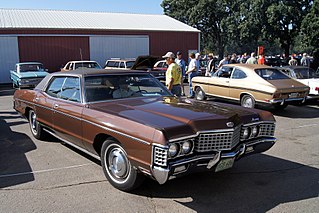
The Mercury Monterey is a series of full-size cars that were manufactured and marketed by the Mercury division of Ford from 1952 to 1974. Deriving its name from Monterey Bay, the initial Mercury Monterey served as the upscale version of the Mercury Custom which replaced the Mercury Eight, the debut model line of the Mercury division. During its production, the Monterey would be offered in multiple body styles, ranging from coupes, convertibles, sedans, hardtops, and station wagons.

The Buick Super is a full-sized automobile produced by Buick from 1940 through the 1958 model years, with a brief hiatus from 1943 through 1945. The first generation shared the longer wheelbase with the top level Roadmaster while offering the smaller displacement engine from the Buick Special. The Super prioritized passenger comfort over engine performance. For several years, it was called the "Buick Eight" or "Super Eight" due to the engravement on the grille while all Buick's since 1931 were all installed with the Buick Straight-8 engine with varying engine displacement.





